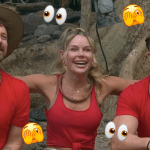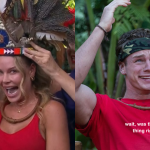
In this, the 94th year of our Archibald, a haunting portrait of Sydney barrister and columnist took out the 2015 top prize.
With the utmost of respect to Nigel Milsom and his beautiful portrait of Charles Waterstreet, ‘Judo house pt 6 (the white bird),’ anyone aware of Australian bred horror film franchises will notice a passing resemblance to Billy the Puppet.


And it is here, in the Venn diagram overlap of ‘Most Important Portraiture Prize in Australia’ and ‘Pop-Culture’, that you will find us attempting to draw tenuous links between .gifs and this year’s entrants. We do this not to be flippant about the prize, because every single finalist this year has proven themselves to be beyond talented and worthy of our pride, but to show a visual representation of what we might yammer on about were we walking around the Art Gallery of NSW viewing the paintings with you.
We have also looked to compile a list that is Gen Y heavy and celebrates a selection of your peers who walk among us, brush in hands, casually bringing beauty to the world one stroke at a time.
Without further adieu, we present our Pedestrian Picks and a few choice words from the finalists themselves:

“I typically create paintings of LGBTQI-identified and queer-allied women, most recently focusing on those who have impacted my life in some way,” said Leutwyler of her work and Ollie’s label-cum-youth empowerment project House of Riot.
She continued: “My work explores the line between glorification, objectification and modification, using patterns and abstractions from each subject’s local and social environment as a subtle vernacular to portray the fluidity and complexities of identity. As a feminist member of the LGBTQI community, Ollie speaks openly about the objectification inherent to a career in modelling, and the unrealistic modification of images that set unattainable standards of beauty.”

The artwork out of Meagher is veeery, hard not to like.
Very hard not to like.

Omar Musa is a deadset ledge.
The artist currently known as Kerry McInnis has apparently been a family friend of the Musas for years, but only recently got to know Omar. “As a fan of hip hop, I thought it might be appropriate to portray Omar in a marginalised role of counter-culture advocate,” she says. “I painted his portrait listening to his rap albums and included phrases from one of his poems, Blood poetry, graffitied onto the stairs of his apartment.”
For anyone not yet acquainted:

Apart from being a beautifully vibrant painting, ‘Delivered’ sends an important message about female sexuality and objectification. And so – because she said it best – in the artist’s own words:
“This self-portrait was based on a performance that we did in Melbourne. It was intentionally public, fast and cheaply documented, to reference the methods of pornography. I was using my body in this work to try to open up a dialogue on female self-objectification (when a woman intentionally sexually objectifies herself). Sometimes I think self-objectification can be constructive. It can be used to claim back ownership of the body or to assert: ‘I can exhibit my sexuality without it amounting to my sexual availability’. Other times I think it can reflect the way the patriarchal value system has been internalised. But I don’t feel you can expect a woman, who has unconsciously internalised “male” values, to see herself as a space where something has been lost. A new identity needs to be forged. I’m interested in this because I’m struggling with it myself. I have difficulty navigating the contradictions and differentiating between internal and external influences, but I see self-portraiture as a potent site for negotiating identity.”

Apart from having the best title, this description by the artist really has a sense of place and time and is straight up  :
:
“I wanted to paint Noel but he hates doing that stuff. Lin was too busy with his footy schedule. Guan wasn’t in the country. So I had to settle for painting [curator] Glenn Barkley. Luckily while Glenn was distracted with showing me how much his cat loved climbing trees (which it definitely didn’t), Lisa Havilah [director of Carriageworks] was there so I painted her instead. Anyway, Lisa is much more prestigious in the arts and is also a lovely person.”
Amazing

| Oil on endure paper
Tim Gregory did his bit towards continuing a very important conversation and created his self-portrait as “a response to the confused, prosaic and performed nature of white Australia.”
“The combination of the redcoat and the convict is not about my own personal heritage, but more broadly about how many Australians still view themselves – as both larrikin/underdog and defender,” says Gregory.
“The painting is deliberately superficial: shiny, saturated, decontextualised. White painters (particularly male painters) in Australia, and the white Australian population more broadly, cannot contribute in any significant way to cultural, political or social evolution until we acknowledge that we are still a colonial country, absurdly and violently layered on top of the world’s oldest, continuous culture.”


| Acrylic on canvas
The incredibly talented Richard Bell entered this year’s competition after he was double-dog-dared to by another artist: “After considerable deliberation, I decided to enter. The subject was never in doubt,” he said. He continued: “I didn’t believe that anyone, other than myself, would trust me to paint their portrait. Especially since I entered so late.” He cites his experience helping his mum decorate cakes ![]() and making tourist art as having contributed to his Olympic-size pool of talent.
and making tourist art as having contributed to his Olympic-size pool of talent.
On the process Bell said: “Numerous mirror trips confirmed the disconcerting fact that it is a mirror image. Finally, it was ready: defiant, assertive, pensive, imploring, confident, dismissively cool and ambivalent.” And in the process summarised all the things we all wish to be when we grow up i.e. Richard Bell.


For this particular oil based love child of Mad Max and Jeffrey Smart artist Juan Ford was inspired by the grossly ill prepared Ludwig Leichhardt, “the Prussian explorer who disappeared mysteriously in the Australian interior” and escaped convict William Buckley, “who lived for over 30 years with the Wathaurong people on the Bellarine” and “later married a woman so short she couldn’t loop her arm through his when they went for an evening stroll.”
He likes the unknowable mysteries surrounding characters such as these, and Australia in general, and how we can only ever apply our own conventions to them and completely misunderstand them.
CC: 
HONOURABLE MENTION to Archibald entry which didn’t make it to the finals by renowned Central Coast watercolourist Grant Molony, for capturing the spirit of ‘Strayan surfing legend Wayne “Rabbit” Bartholomew with 





